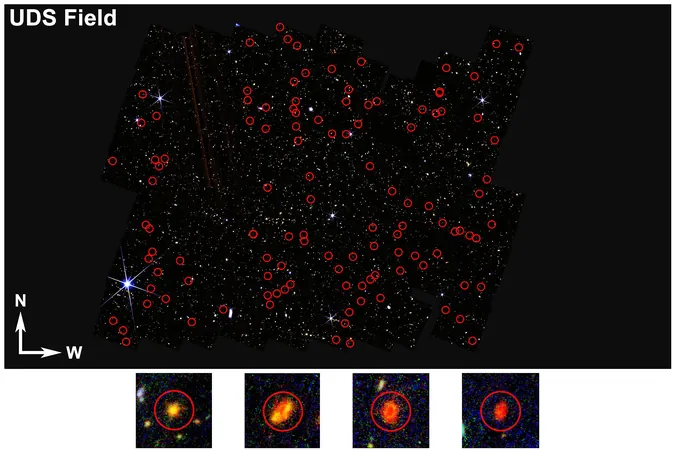
Unveiling the Cosmos: 300 Mysterious Bright Objects Could Redefine Our Understanding of Early Galaxies
2025-08-17
Author: Rajesh
Discoveries from the James Webb Space Telescope
A groundbreaking study from researchers at the University of Missouri has uncovered 300 extraordinarily bright objects in the vastness of space, potentially marking some of the earliest galaxies ever observed. These cosmic wonders were identified through images captured by the James Webb Space Telescope (JWST) and exhibit a striking phenomenon: they fade from view in blue light but shine brightly in redder wavelengths.
What Makes These Objects Stand Out?
Led by physicists Liu Bangzheng "Tom" Sun and Haojing Yan, the research team meticulously sifted through public JWST images. They cataloged these luminous "dropouts," honing in on 137 that also presented mid-infrared measurements—an approach that significantly narrows down the search for distant galaxies.
Two Potential Origins
The findings suggest that while many of these bright dropouts are relatively nearby, with redshifts around z ≈ 1-4, a notable fraction may indeed be from the early universe, with redshifts exceeding 6. Haojing Yan highlights the potential significance: "These mysterious objects are candidate galaxies in the early universe, meaning they could be very early galaxies." This duality of origin adds an intriguing layer to the research.
Understanding Redshift and the Infrared Realm
Throughout their cosmic journey, light stretches into longer wavelengths, creating what astronomers call redshift. This phenomenon pushes ancient galaxies out of optical range and into the infrared spectrum, where JWST excels. Its Near Infrared Camera (NIRCam) observes wavelengths from 0.6 to 5.0 microns, while the Mid Infrared Instrument (MIRI) extends this further, bolstering our ability to study these distant cosmic entities.
The Detecting Method: High-Redshift Dropout Technique
Utilizing the "dropout technique," which detects a drop in brightness at shorter wavelengths while capturing brightness at longer ones, the researchers employed various spectral energy distribution fitting tools to estimate their photometric redshifts. This method, established in the 1990s and refined over time, is key to identifying high-redshift galaxies.
An Exceptional Case of Cosmic Brightness
Among these intriguing objects lies a notable source found in the CEERS field at redshift z = 8.68. Initially spotted through ground-based Keck data, this galaxy sparked interest due to its distinct infrared color, hinting at robust oxygen emissions. Subsequent JWST observations uncovered signatures of an active black hole and vigorous star formation in its vicinity.
Challenging Existing Theories of Galaxy Formation
While not every bright dropout is ancient, the presence of even a few could challenge our established models of galaxy formation. Theoretical simulations indicate that increased star formation efficiency in massive halos could reproduce luminous early galaxies, yet the brightest of these remain an enigma.
The Need for Continued Investigation
As Sun and Yan emphasize, spectroscopy is vital for confirming these cosmic candidates, given that dusty galaxies at lower redshifts can mimic the colors associated with extreme distance. This cautious approach is prudent, especially since identifying strong absorption features can be tricky, blurring the lines between distant and nearby sources.
Conclusion: A Call to Action for Astronomers
As researchers eagerly pursue follow-up studies, the promise of these discoveries could herald a new chapter in our understanding of the early universe. Whether these bright objects are indeed distant galaxies or something else entirely, one thing is certain: they invite us to rethink the story of our cosmic origins.


 Brasil (PT)
Brasil (PT)
 Canada (EN)
Canada (EN)
 Chile (ES)
Chile (ES)
 Česko (CS)
Česko (CS)
 대한민국 (KO)
대한민국 (KO)
 España (ES)
España (ES)
 France (FR)
France (FR)
 Hong Kong (EN)
Hong Kong (EN)
 Italia (IT)
Italia (IT)
 日本 (JA)
日本 (JA)
 Magyarország (HU)
Magyarország (HU)
 Norge (NO)
Norge (NO)
 Polska (PL)
Polska (PL)
 Schweiz (DE)
Schweiz (DE)
 Singapore (EN)
Singapore (EN)
 Sverige (SV)
Sverige (SV)
 Suomi (FI)
Suomi (FI)
 Türkiye (TR)
Türkiye (TR)
 الإمارات العربية المتحدة (AR)
الإمارات العربية المتحدة (AR)